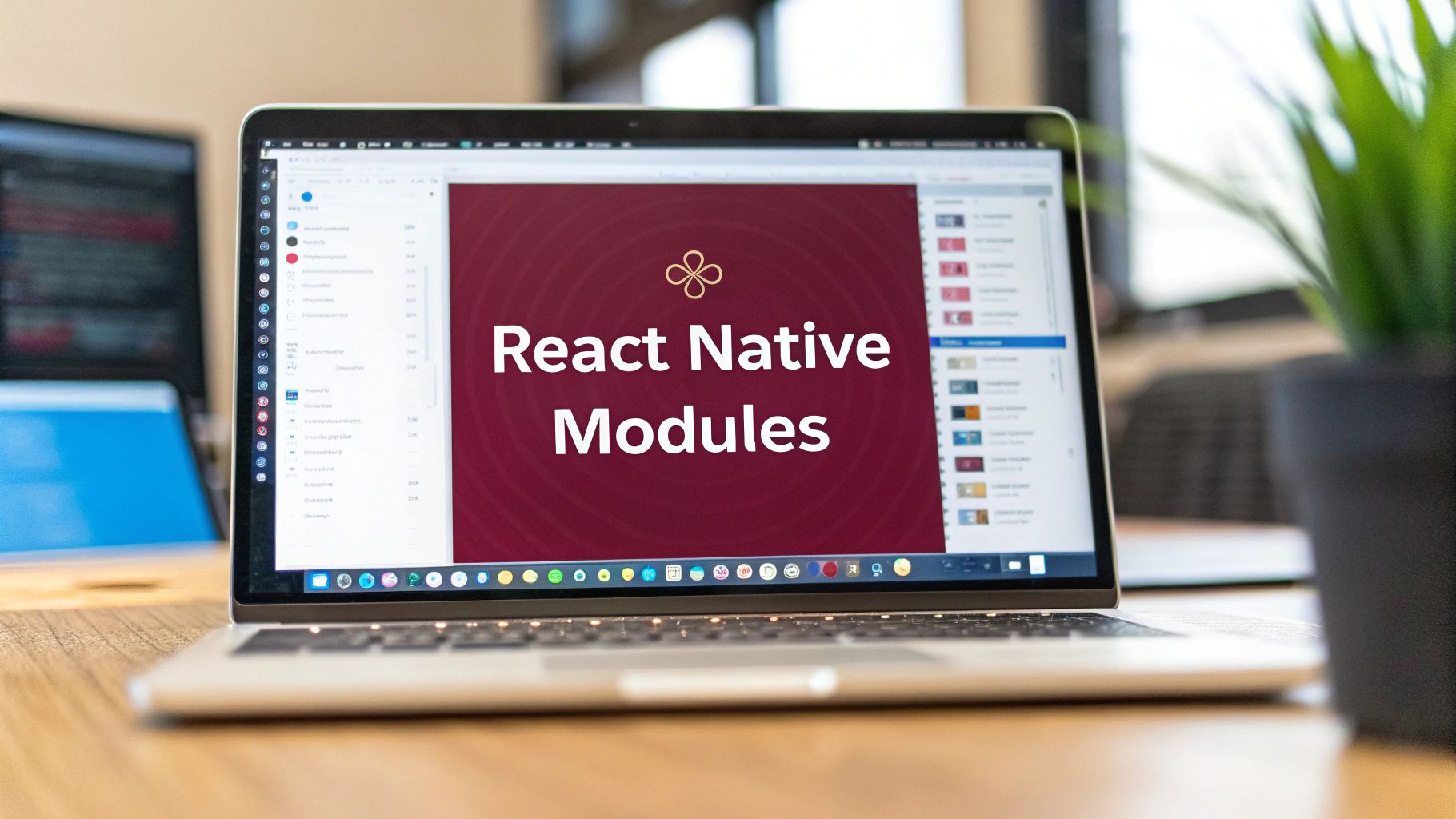Building a high-performance React Native app is like constructing a skyscraper-success depends on using the right building blocks. In the world of React Native, these blocks are modules. They handle everything from sleek UI animations to complex device API integrations, forming the core of your application’s functionality.
But with thousands of options scattered across npm, GitHub, and various marketplaces, finding reliable, well-maintained, and secure react native modules can feel overwhelming. Choosing an unvetted module can introduce bugs, security vulnerabilities, or performance bottlenecks that derail your project entirely. This guide cuts through the noise.
We’ve curated the 12 most essential resources for discovering and evaluating packages, from official directories and code repositories to specialized marketplaces and security tools. You will learn not just where to look, but also how to critically evaluate each module to ensure it meets your project’s standards for quality, security, and long-term viability. This list provides the direct links and insights you need to find the perfect components, accelerate your development, and build an exceptional app.
1. CodePushGo
CodePushGo is a premier platform dedicated to streamlining over-the-air (OTA) code updates for React Native applications. It stands out by enabling development teams to bypass traditional app store review delays, pushing critical bug fixes, features, and security patches directly to users’ devices in minutes. This capability is essential for modern agile workflows and significantly accelerates release cycles while improving the end-user experience.
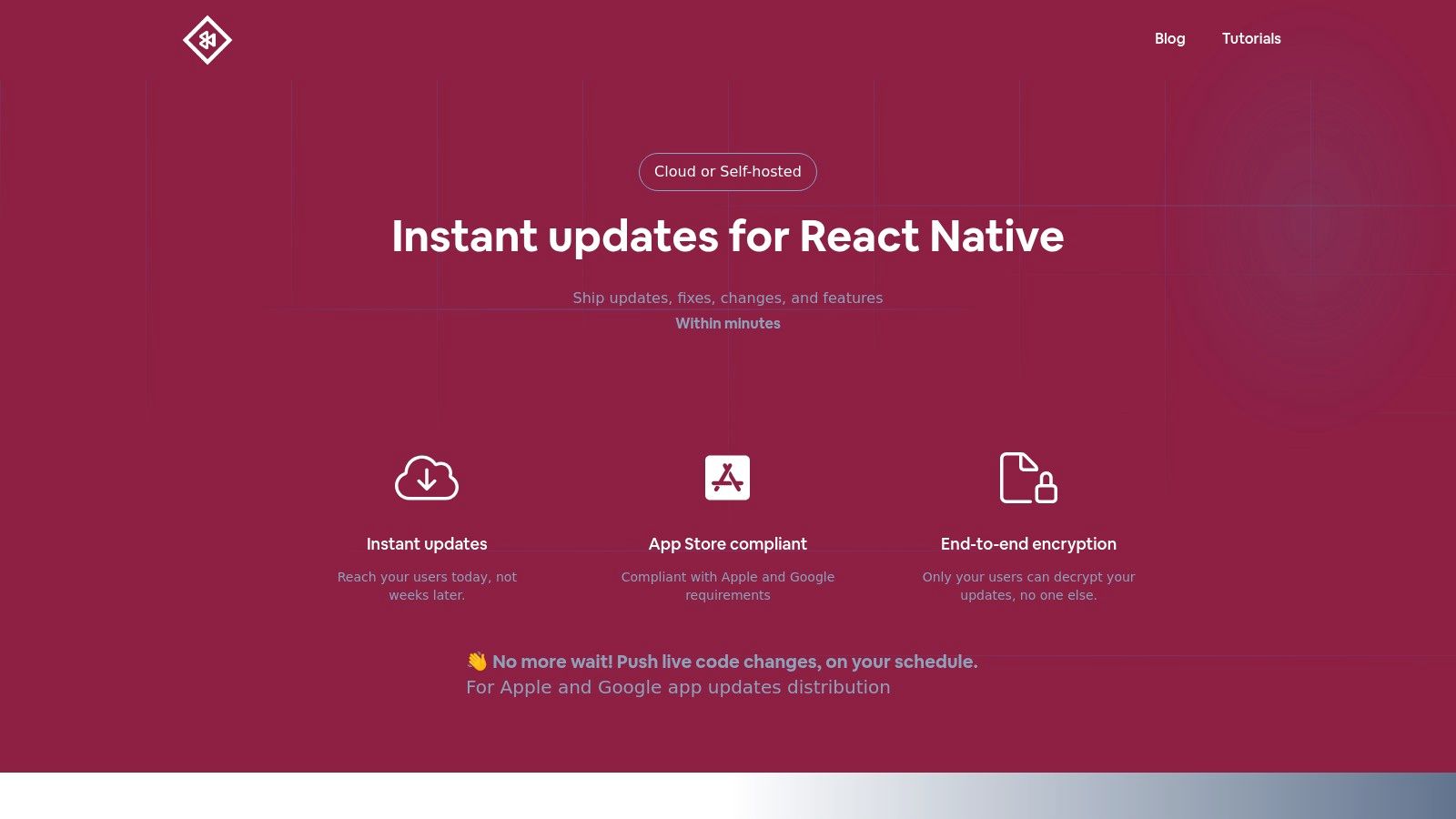
Its architecture is built on a foundation of security and efficiency, adhering fully to Apple and Google guidelines for live updates. For teams working with sensitive data, its unique end-to-end encryption is a game-changer, ensuring that only the end user’s device can decrypt the update payload.
Key Features and Use Cases
CodePushGo offers a comprehensive suite of tools designed for reliability and control.
- Instant, Compliant OTA Updates: Deploy JavaScript and asset changes directly to users without a new app store submission. This is ideal for fixing critical bugs post-launch or A/B testing new features with a subset of users.
- End-to-End Encryption: A critical feature for enterprise and security-conscious applications. CodePushGo ensures that the update bundles are secure from the moment they leave your CI/CD pipeline until they are decrypted on the end-user’s device.
- Smart Differential Updates: To conserve user data and speed up downloads, the platform only sends the code that has changed. This is particularly beneficial for users in regions with limited or expensive mobile data.
- Staged Rollouts: Mitigate risk by using the channel-based system to release updates to a small percentage of users first (e.g., 10%), monitor real-time analytics for issues, and then gradually roll out to your entire user base.
- Flexible Hosting: Choose between a fully managed cloud service or a self-hosted environment for complete data control, integrating seamlessly with tools like GitHub Actions and Jenkins.
Pricing and Access
CodePushGo’s model is designed for scalability and transparency, avoiding vendor lock-in with its open-source foundation.
- Initial Setup: A one-time setup fee of $2,600.
- Ongoing Costs: Approximately $300/month for CI/CD and hosting, which is significantly more cost-effective than managed competitors like AppFlow.
- Access: Visit the official website for detailed documentation and to get started.
Why It’s a Top Choice
CodePushGo distinguishes itself from other OTA update solutions by combining enterprise-grade security, deployment flexibility, and a cost-effective, vendor-neutral model. Its robust feature set empowers developers, product managers, and DevOps engineers to implement a truly agile and secure release process. The granular control over deployments, combined with insightful analytics, makes it an indispensable tool among modern react native modules for any serious development team.
Website: https://codepushgo.com
2. React Native Directory
React Native Directory is the canonical, community-driven database for finding and comparing React Native modules. As the officially referenced catalog in the React Native documentation, it serves as the most trusted first stop for developers seeking new libraries. Its primary strength lies in its powerful filtering and scoring system, which allows you to quickly assess a module’s health and compatibility.
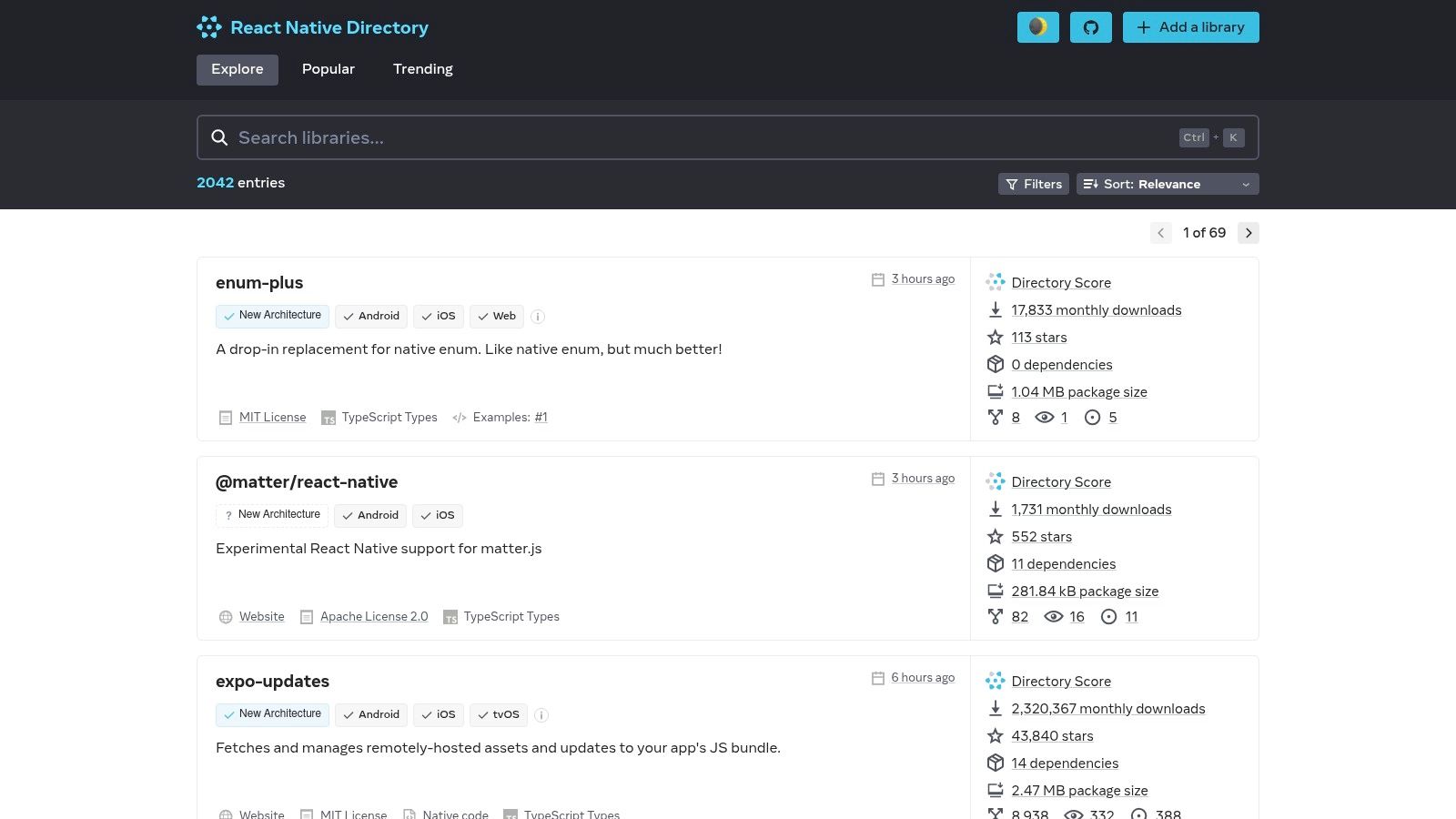
The platform’s interface is clean and purpose-built for efficient searching. You can filter packages by platform support (iOS, Android, Web, Windows, etc.) and, most importantly, Expo compatibility. Each listing includes a “Directory Score” based on maintenance signals like recent commits and open issues, offering a quick heuristic for a library’s viability. This makes it an invaluable tool for tasks like finding the best analytics libraries for your React Native app.
Key Features and Usage Tips
- Platform Filtering: Instantly narrow down modules that support your target platforms, including macOS, tvOS, and Web.
- Directory Score: Use the score as a starting point, but always click through to the GitHub repository to verify recent activity and community health yourself.
- Public API: Developers can programmatically query the directory, which is useful for building custom tooling or analysis scripts.
Pros:
- Curated and officially referenced resource
- Excellent compatibility and health signals
Cons:
- New npm packages may have a delay before appearing
- The score is a heuristic and not a substitute for manual review
Website: https://reactnative.directory/
3. npm (The npm Registry)
The npm Registry is the foundational, authoritative source where nearly all React Native modules are published and discovered. As the default package manager for Node.js, it is the de facto central hub for the entire JavaScript ecosystem, including libraries built specifically for React Native. Its primary role is providing the infrastructure for developers to publish, version, and install packages directly into their projects.
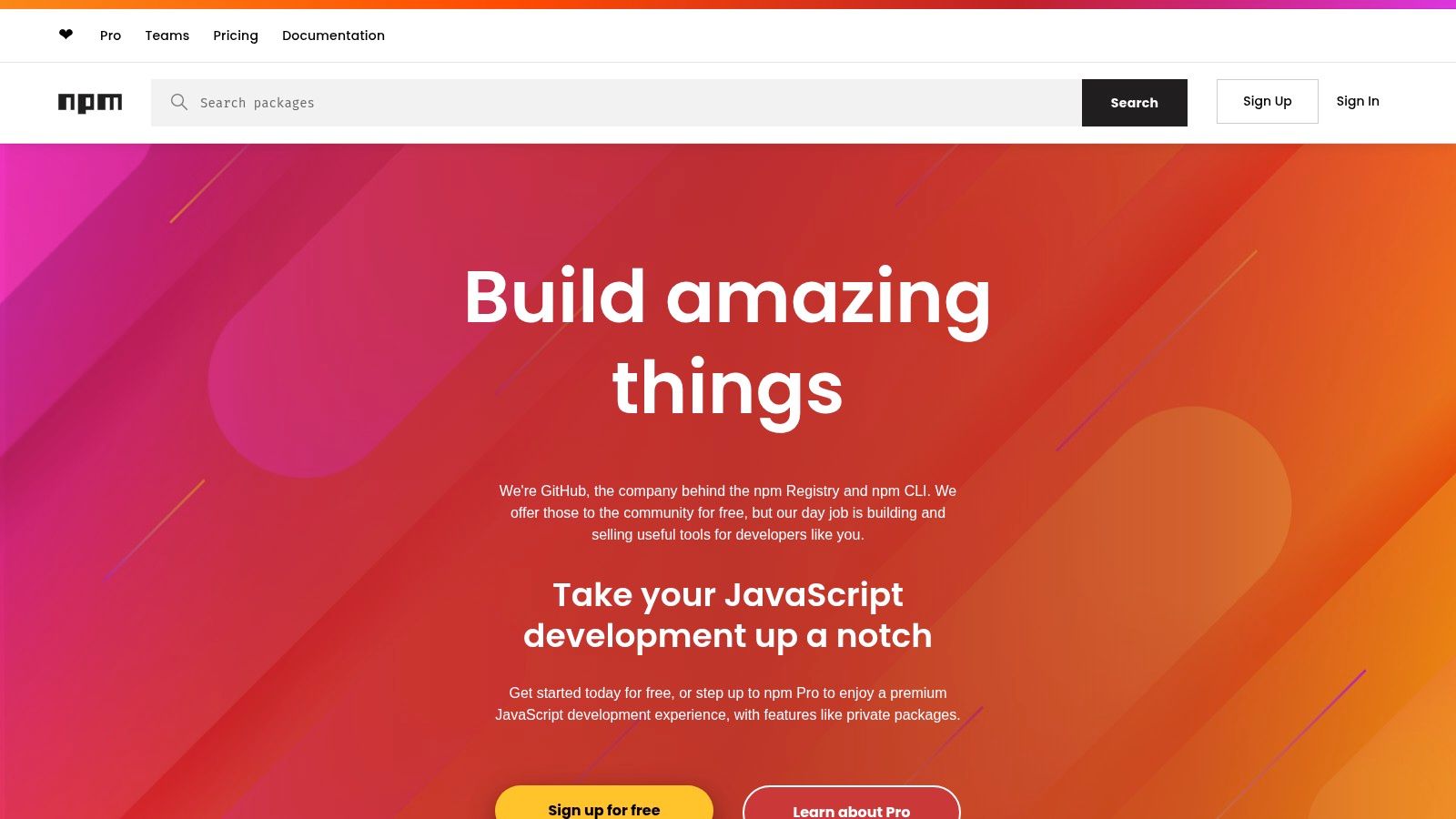
While not a curated directory, npm is indispensable for its raw, unfiltered access to every available module. Each package page offers vital metadata, including version history, weekly download statistics, dependencies, and direct links to the source repository. This makes it the ultimate ground truth for verifying a package’s existence and retrieving installation commands. For organizations needing more control, exploring a private npm registry for your team is a common next step.
Key Features and Usage Tips
- Version History: Use the “Versions” tab to check for recent updates or find specific older versions for compatibility needs.
- Weekly Downloads: Gauge a module’s popularity and adoption by checking its download stats, but remember high numbers don’t always mean high quality.
- Source Links: Always follow the repository link to inspect the code, open issues, and pull requests before installing a module.
Pros:
- Definitive source for JavaScript and React Native packages
- Up-to-the-minute releases and version history
Cons:
- Not all packages are React Native-compatible; user must verify
- Limited health and maintenance signals on npm alone
Website: https://www.npmjs.com/
4. GitHub (topics and repos)
GitHub is the primary source code repository for nearly all React Native modules. Going directly to the source allows developers to access not just the code itself but also crucial indicators of a library’s health, such as open issues, pull requests, recent commits, and release notes. Using GitHub’s topic pages, like react-native-package or native-module, provides a powerful discovery mechanism for finding new and popular tools.
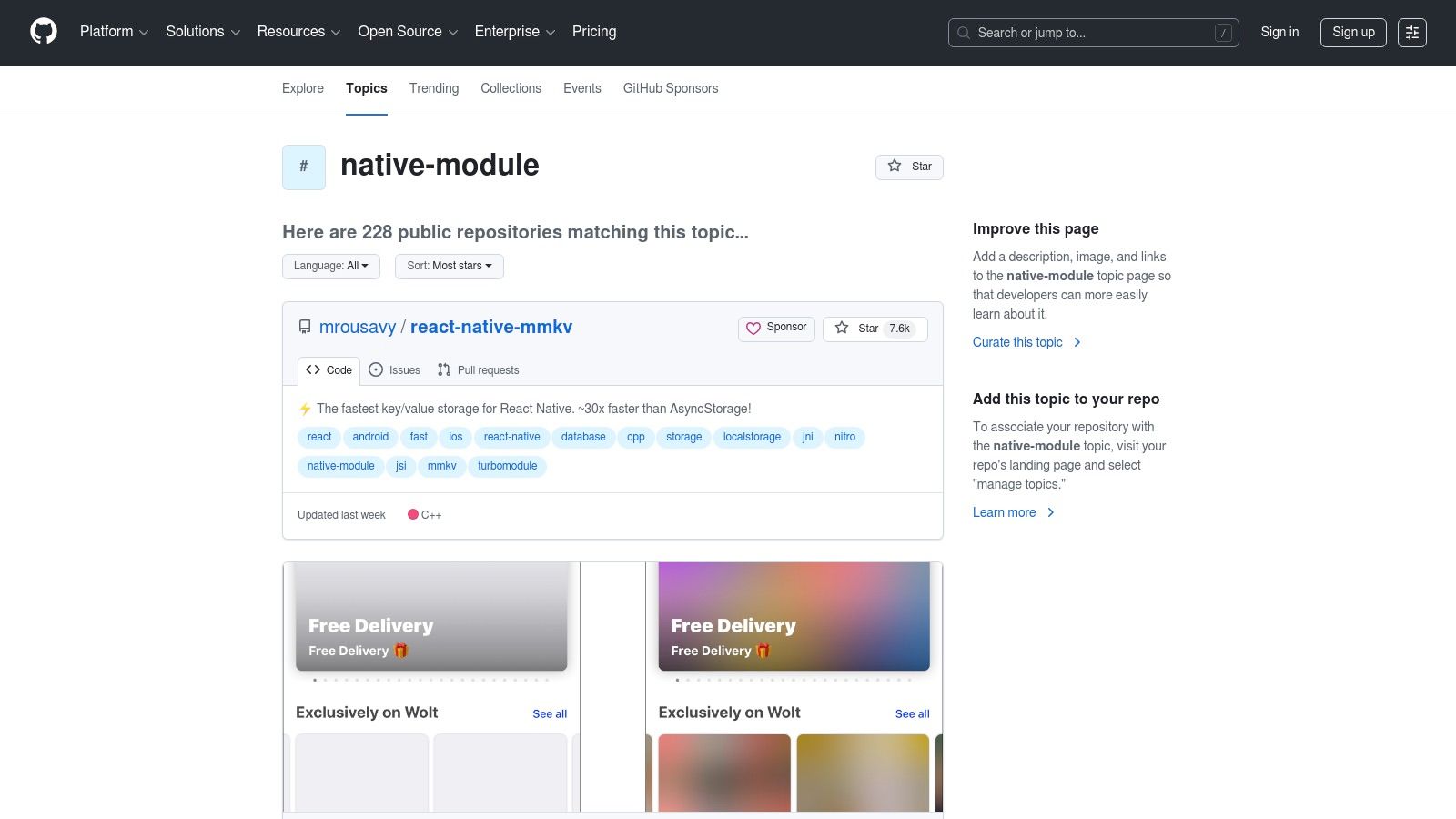
Unlike curated directories, GitHub offers an unfiltered view into a module’s development lifecycle. You can directly assess code quality, check for automated tests, and even see how maintainers interact with the community. This transparency is invaluable for evaluating a library’s stability and support for new architectures, like the New Architecture (Fabric/TurboModules). Furthermore, you can enhance your workflow by setting up automated checks for these modules, a topic detailed further in this guide to GitHub Actions for React Native.
Key Features and Usage Tips
- Maintenance Signals: Analyze the commit history, open issues, and pull request activity to gauge if a project is actively maintained.
- Topic-Based Discovery: Use topic pages like “react-native-package” to explore libraries, but be prepared to vet them yourself.
- Release Notes: Always check the “Releases” tab for changelogs and breaking changes before upgrading a module.
Pros:
- Complete transparency to assess code quality, tests, and CI
- Often the fastest place to find support for new architectures and bug fixes
Cons:
- Discovery via topics can be noisy with varied curation quality
- Requires more manual effort to evaluate a library’s health
Website: https://github.com/topics/native-module
5. Expo (Modules API docs and SDK packages)
Expo’s official documentation is an essential resource for developers building modern React Native modules. It provides the definitive guide to the Expo Modules API, which simplifies creating high-performance native modules using Swift and Kotlin. This makes it the go-to platform for learning how to bridge native functionality into a React Native app, whether you are building for the Expo ecosystem or a bare project.
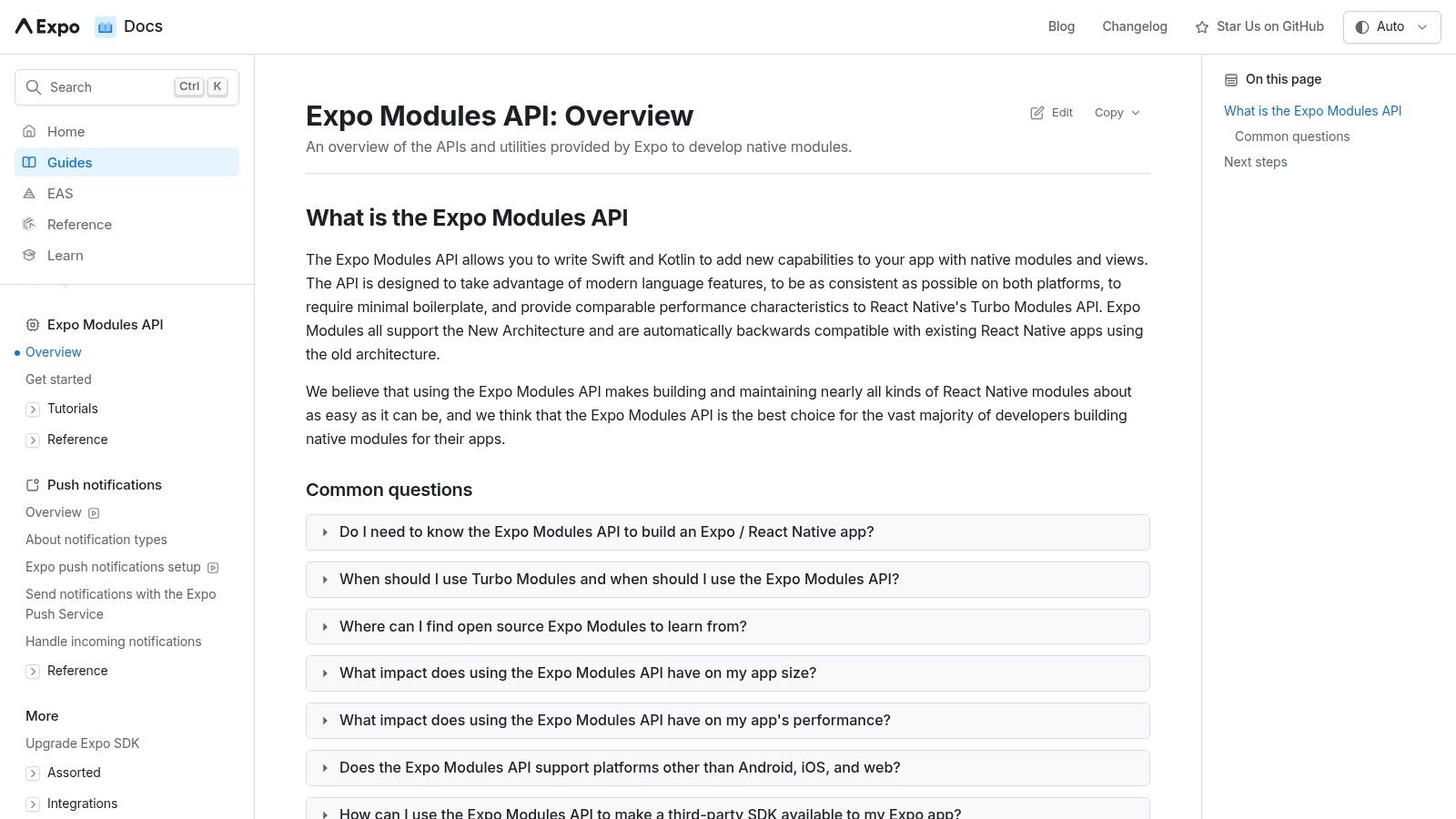
The documentation stands out by offering clear, step-by-step tutorials for everything from creating your first module to wrapping complex third-party native libraries. Its detailed SDK package references and integrated Snack examples allow for quick experimentation. For developers deciding between development approaches, understanding Expo’s module system is critical, as detailed in this comparison of Expo vs. bare React Native.
Key Features and Usage Tips
- Expo Modules API: Learn to write future-proof native modules in Swift and Kotlin that are compatible with React Native’s New Architecture.
- Step-by-Step Tutorials: Follow comprehensive guides for creating new modules or wrapping existing native code for use in your app.
- Extensive SDK Docs: Browse detailed documentation for all official Expo SDK packages, complete with API references and usage examples.
Pros:
- Up-to-date guidance on New Architecture–ready modules
- Clear integration for both Expo and bare React Native projects
Cons:
- Documentation depth can vary between modules
- Complex native integrations still require significant native expertise
Website: https://docs.expo.dev/modules/overview/
6. Envato Market – CodeCanyon
Envato Market’s CodeCanyon is a massive marketplace for production-ready React Native modules, templates, and full application starter kits. While it doesn’t offer individual npm packages, it serves developers looking for a significant head start by providing complete, pre-built codebases. These assets often bundle together numerous UI components, navigation structures, and feature integrations that can be purchased and adapted.
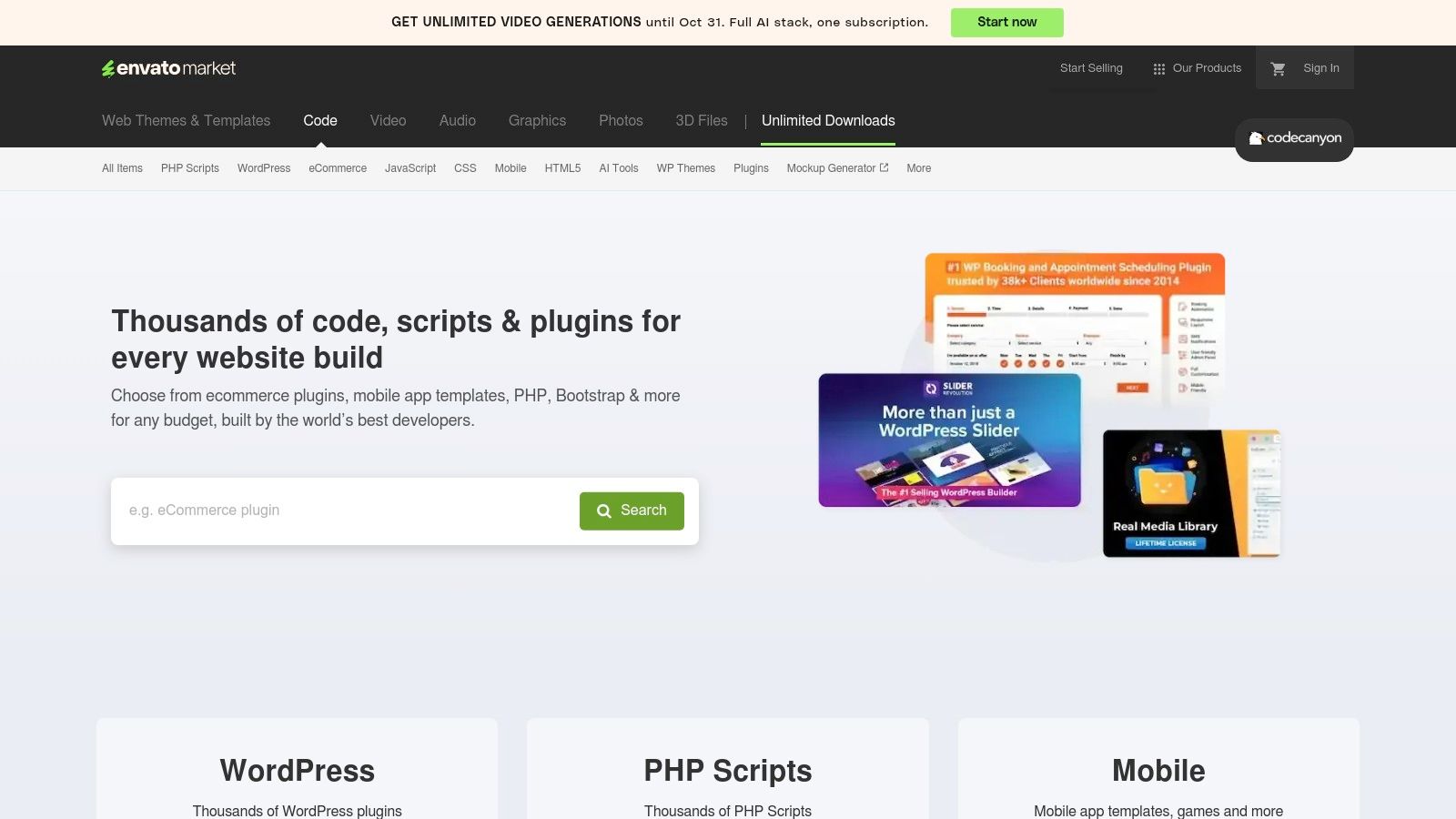
The platform is ideal for accelerating development on common app types like e-commerce stores, social networks, or delivery services. Each product page details pricing, recent updates, supported framework versions, and a feature list. This allows you to evaluate whether a template’s pre-built components align with your project goals before purchasing. Many listings also provide live demos and access to customer support from the original author.
Key Features and Usage Tips
- Diverse Templates: Find starter kits for dozens of app categories, including booking, finance, and media streaming.
- Vet Thoroughly: Always check the item’s last update date, read recent reviews, and test the live preview to ensure quality and compatibility with the latest React Native versions.
- Support and Updates: Look for sellers with a strong track record of providing updates and responding to support questions, as this is crucial for long-term project viability.
Pros:
- Saves significant development time with complete starter kits
- Clear one-time pricing and often includes future updates
Cons:
- Code quality can vary significantly between authors
- Integrating a large template into an existing project can be complex
Website: https://codecanyon.net/
7. React Native Market
React Native Market is a specialized marketplace for premium, pre-built React Native modules, templates, and starter kits. Unlike general-purpose directories, it offers a curated collection of production-ready assets designed to accelerate development. The platform is developer-run, ensuring that the offerings are practical, well-documented, and often built with popular libraries like Expo and React Native Paper.
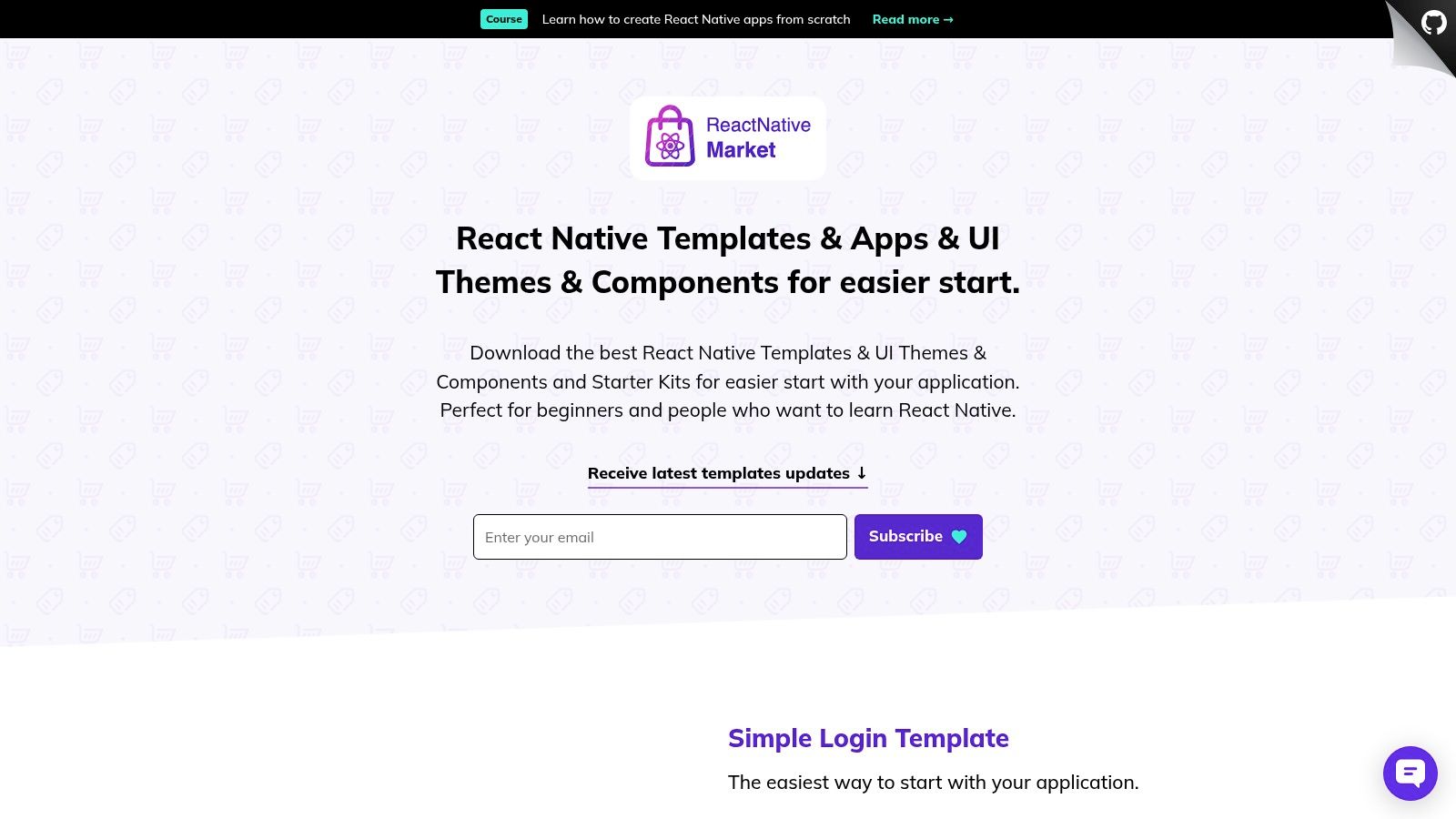
The primary appeal is its focus on complete, functional solutions. Instead of sourcing individual UI components, you can purchase an entire authentication flow, a Firebase-integrated dashboard, or a fully styled settings screen. Each product includes live demos, clear documentation, and TypeScript support, making it an excellent resource for developers on a tight deadline or those looking to quickly bootstrap a new project with high-quality, minimal-dependency code. This focus makes it a great place to find solutions when building complex features.
Key Features and Usage Tips
- Live Demos: Always use the interactive demos to test the functionality and user experience before purchasing a template.
- TypeScript-Ready: Most kits come with TypeScript support out of the box, saving you significant setup and configuration time.
- Example Repositories: Look for the associated example repositories to understand the implementation and integration patterns before you buy.
Pros:
- Developer-run store focused solely on React Native
- Clear scope and faster onboarding for beginners with pre-built solutions
Cons:
- Smaller, curated catalog compared to larger marketplaces
- Products are premium and require a one-time purchase
Website: https://reactnativemarket.com/
8. Bit (bit.dev) – Component hub for React Native
Bit is a component-driven development platform that excels at helping teams build, version, and share React Native modules, specifically UI components, across different projects. It allows developers to isolate individual components from a monolithic app and publish them independently, complete with their own documentation, tests, and dependency graphs. This makes it an invaluable tool for creating and maintaining a consistent design system.
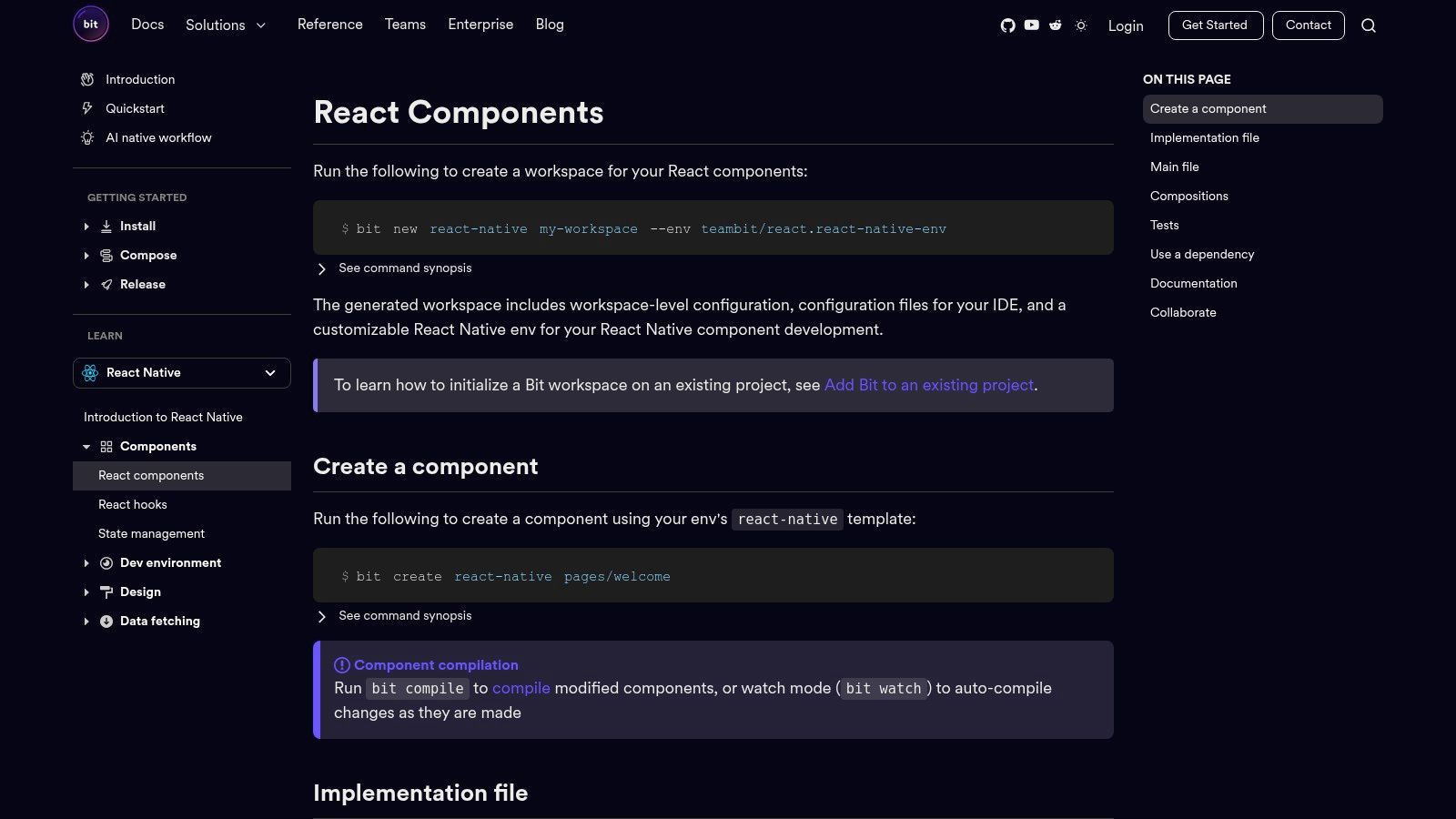
Unlike a simple package manager, Bit provides a rich environment for component discovery and collaboration. Each component has its own isolated preview, allowing developers to see and interact with it before integration. While its core strength is in UI, its principles of modularity can be applied to other shareable logic, making it a powerful platform for teams focused on reusability and scalable front-end architecture.
Key Features and Usage Tips
- Atomic Component Sharing: Publish individual components directly from your repository without creating a new package for each one.
- Built-in Documentation and Testing: Each component on Bit comes with its own documentation, rendered examples, and test results, creating a living style guide.
- Dependency Visualization: Understand how components relate to each other with an automatically generated dependency graph.
Pros:
- Promotes extreme reusability and modularity, perfect for internal design systems
- Excellent developer experience with integrated docs and testing sandboxes
Cons:
- Primarily focused on UI components rather than native API modules
- Can introduce a learning curve for teams unfamiliar with component-driven development
Website: https://bit.dev/docs/react-native-components/react-native-components/
9. Libraries.io
Libraries.io is a massive index of open-source packages from dozens of different package managers, including npm. While not specific to React Native, it serves as a powerful meta-search engine for discovering and vetting React Native modules. Its key advantage is aggregating metadata from multiple sources like GitHub, npm, and other registries, providing a holistic view of a library’s health and history that you can’t get from a single source.
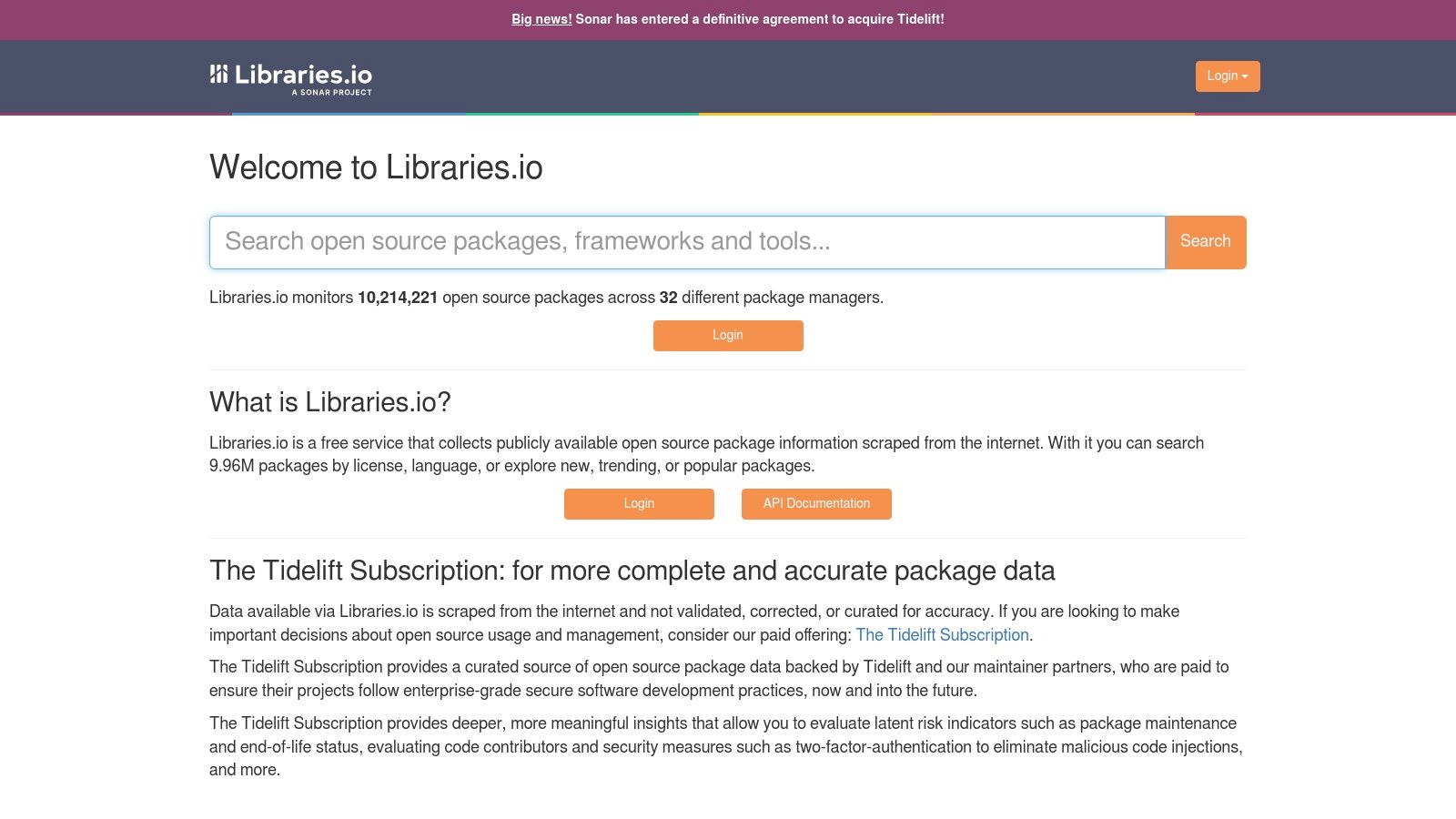
The platform presents a detailed timeline for each package, showing every release, its dependencies, and dependents. This dependency graph is invaluable for understanding the potential impact of adding a new library to your project. Its “SourceRank” score analyzes various signals to provide a quick assessment of package quality. For developers, it’s a critical tool for due diligence, complementing more specialized discovery platforms and standing as one of the essential React Native development tools.
Key Features and Usage Tips
- Dependency Tracking: Explore a module’s dependencies and see which other popular packages rely on it before you commit.
- SourceRank Score: Use the comprehensive score to quickly gauge a library’s overall health and community adoption.
- Release History: Easily view the entire version history to check for maintenance frequency and potential breaking changes.
Pros:
- Aggregates data from multiple sources for a complete picture
- Helpful for a quick health snapshot before adding dependencies
Cons:
- Not curated specifically for React Native; requires skilled searching
- The sheer volume of data can be overwhelming for new users
Website: https://libraries.io/
10. Snyk Advisor (Package health and security)
Snyk Advisor provides an essential security and health-check layer when you’re evaluating new React Native modules. While not specific to React Native, it serves as an independent auditor for any npm package, offering a comprehensive risk assessment before you add a new dependency. The platform analyzes packages for security vulnerabilities, maintenance status, community activity, and overall popularity, presenting the data in an easy-to-digest “Package Health Score.”
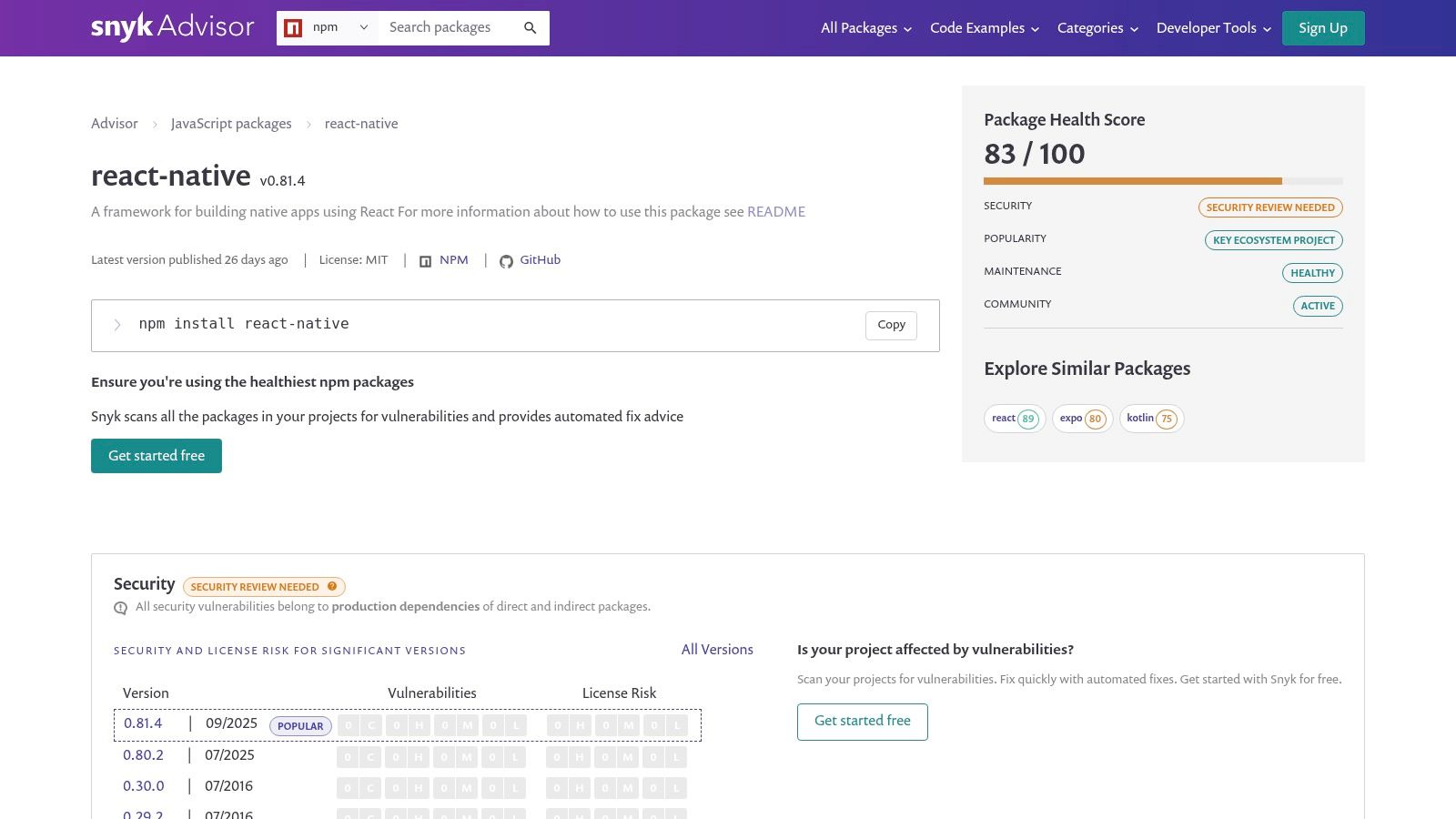
This tool is invaluable for security-conscious teams who need to vet third-party code thoroughly. By simply searching for a module, you get immediate insights into its security posture, including known vulnerabilities and their severity. It complements resources like npm or GitHub by focusing explicitly on risk, helping you avoid packages that might introduce security flaws or become unmaintained liabilities in your project.
Key Features and Usage Tips
- Package Health Score: Use the overall score (out of 100) as a quick benchmark, but dive into the individual security, maintenance, and popularity metrics for a complete picture.
- Vulnerability Checks: Review the security tab for a list of known vulnerabilities. Snyk provides links to detailed reports on each issue.
- Dependency Tree Analysis: Snyk Advisor also shows the health of a module’s own dependencies, revealing potential risks inherited from other packages.
Pros:
- Provides an independent, security-focused health assessment
- Excellent for vetting dependencies and reducing project risk
Cons:
- Not specific to React Native; some metrics are generalized for the npm ecosystem
- Deeper security details and remediation advice may require a Snyk account
Website: https://snyk.io/advisor/npm-package/react-native
11. Awesome React Native (GitHub curated list)
Awesome React Native is a classic, community-curated GitHub repository that serves as a massive index of React Native modules, tools, and learning materials. As part of the popular “Awesome” list series, it provides a well-organized starting point for discovering popular libraries across various categories, from UI components to backend services. Its value lies in its breadth, offering a panoramic view of the ecosystem beyond just npm packages.
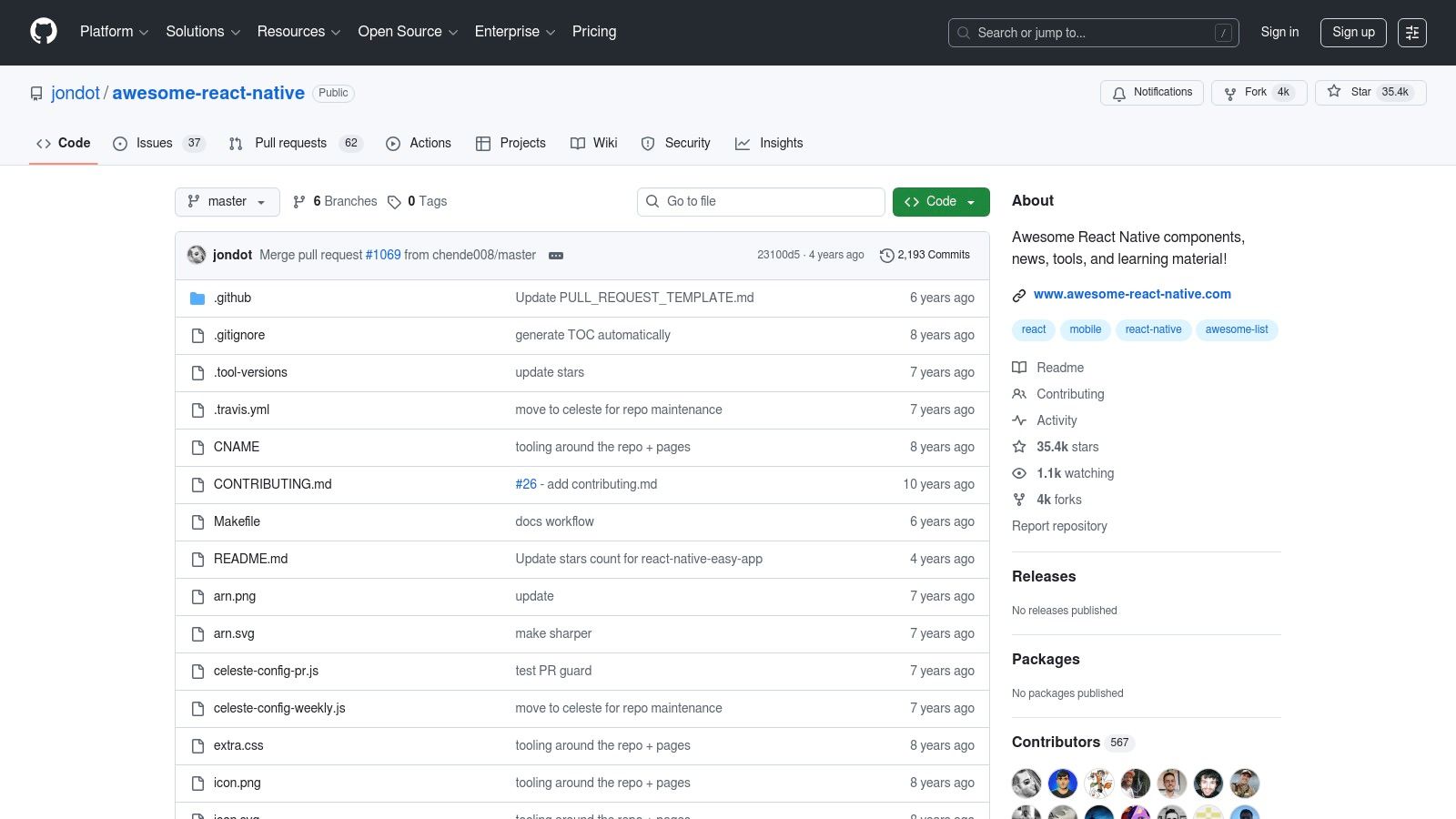
The repository is structured into clear categories like “UI,” “Navigation,” and “Build & Development,” making it easy to browse for solutions to specific problems. While it lacks the automated scoring of dedicated directories, it often includes resources that others miss, such as articles, tutorials, and development tools. It’s an excellent resource for exploring established and community-vetted options before diving deeper into their specific metrics on other platforms.
Key Features and Usage Tips
- Broad Categories: Quickly find relevant tools by browsing logical sections, including libraries, open-source apps, and media content.
- Discover Adjacent Tooling: The list includes build tools, debugging aids, and styling solutions that are essential but might not be standard npm packages.
- Cross-Reference: Use this list for discovery, then cross-reference promising libraries on React Native Directory or npm to check their maintenance status and compatibility.
Pros:
- A wide variety of resources beyond just libraries
- Well-organized categories for easy browsing
- Community-driven and frequently updated
Cons:
- Lacks automated health scores or compatibility filters
- Inclusion is subjective and requires manual vetting by the user
Website: https://github.com/jondot/awesome-react-native
12. Ignite Cookbook (by Infinite Red)
Ignite Cookbook is a practical recipe collection from the renowned React Native consultancy, Infinite Red. Rather than a simple database of React Native modules, it offers opinionated, battle-tested solutions to common development challenges. It serves as a learning resource, guiding developers on how to integrate and use specific libraries effectively within a production-grade architecture.
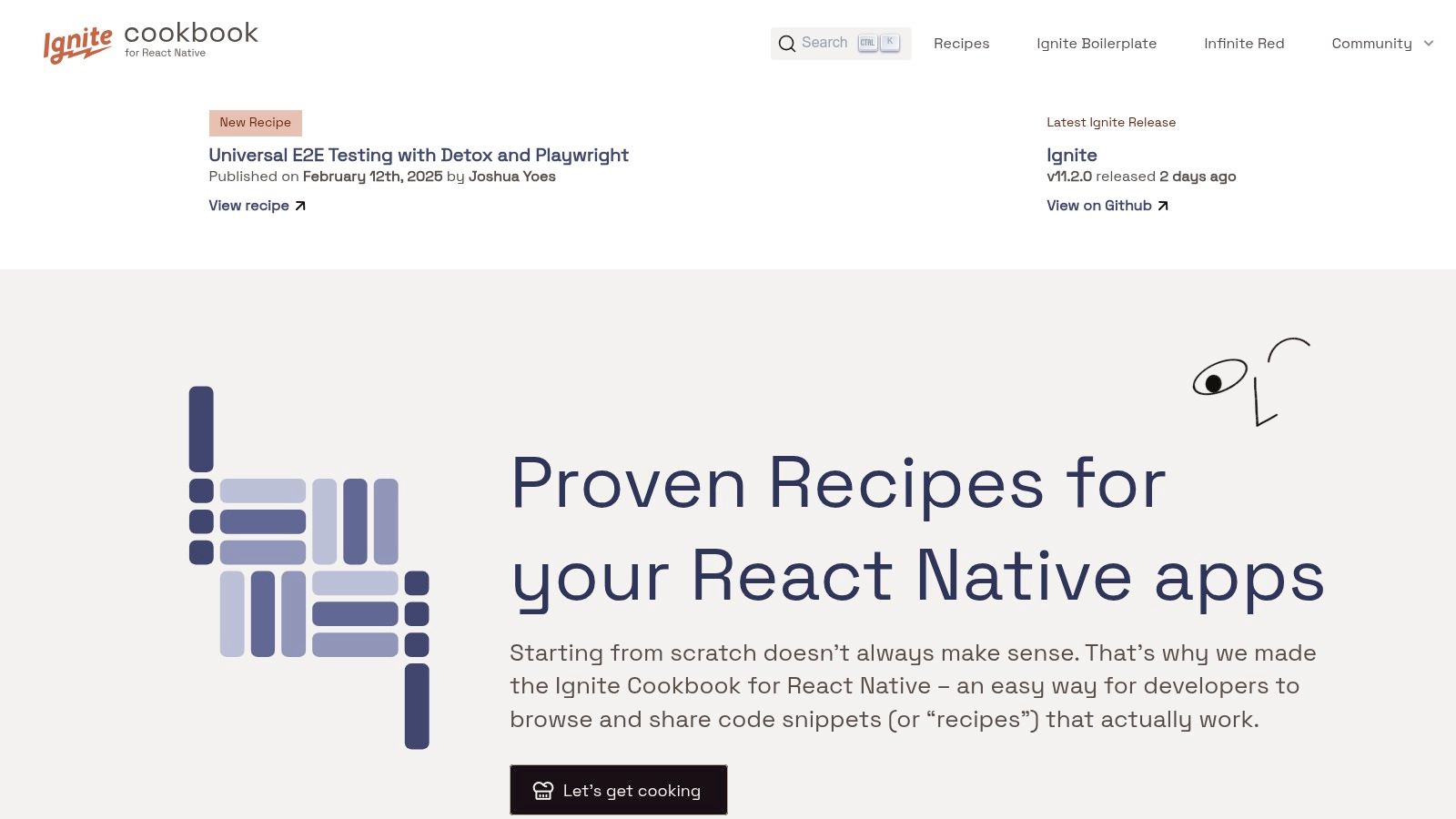
The platform’s strength lies in its focus on real-world patterns and working setups. Instead of just listing a module, a “recipe” will walk you through its integration, configuration, and practical usage with code snippets. This practitioner-led approach is invaluable for understanding not just what a module does, but how to use it correctly alongside other tools. It’s an excellent resource for moving from theory to implementation.
Key Features and Usage Tips
- Practical Recipes: Find step-by-step guides for common tasks, such as setting up state management with MobX-State-Tree or implementing push notifications.
- Tooling Guidance: The cookbook offers advice on tooling and boilerplate integrations, reflecting Infinite Red’s extensive experience.
- Contextual Learning: Use the recipes to understand why certain modules are chosen and how they fit into a larger application structure, rather than just grabbing a package name.
Pros:
- Practical, tested approaches from industry experts
- Focus on workable integration patterns and best practices
- Free and openly accessible learning resource
Cons:
- Not a comprehensive module registry; selection is curated and limited
- Recipes may reflect the specific stack used in their Ignite boilerplate
Website: https://ignitecookbook.com/
Top 12 React Native Modules: Feature Comparison
| Product | Core Features/Characteristics | User Experience / Quality Metrics | Value Proposition | Target Audience | Price Points |
|---|---|---|---|---|---|
| CodePushGo 🏆 | Instant OTA updates, end-to-end encryption, smart differential updates, CI/CD integrations, staged rollouts ✨ | 95% update rate in 24h ★★★★☆, real-time analytics | Cost-effective 💰, open-source, vendor-neutral | React Native dev teams 👥 | $2,600 setup + ~$300/month 💰 |
| React Native Directory | Curated React Native modules catalog, powerful filters, public API | Trusted resource ★★★☆☆, popularity & maintenance scores | Fast compatibility comparison 💰 | Devs seeking React Native libs 👥 | Free |
| npm (The npm Registry) | JavaScript package registry, install commands, usage stats, maintainer info | Up-to-date releases ★★★☆☆, version metadata | Definitive package source 💰 | JavaScript & React Native devs 👥 | Free |
| GitHub (topics and repos) | Source code, issues, PRs, commits, community discussions | Transparency ★★★★☆, maintenance signals | Fast support & discovery ✨ | Open-source contributors 👥 | Free |
| Expo (Modules API docs & SDK) | Expo Modules API, tutorials, SDK docs, Snack tool | Up-to-date guidance ★★★☆☆, integration clarity | Expo + bare React Native integration 💰 | Expo and React Native devs 👥 | Free |
| Envato Market – CodeCanyon | React Native templates, UI kits, starter apps marketplace | Varies by product ★★★☆☆ | Time-saving starting points 💰 | Developers needing ready code 👥 | Paid, varies 💰 |
| React Native Market | Curated templates/components, TypeScript support, live demos | Developer-run store ★★★☆☆ | Focused React Native shop 💰 | Beginners & intermediate devs 👥 | Paid, varies 💰 |
| Bit (bit.dev) – Component hub | Component sharing/versioning, docs, tests, dependency graphs | Good developer experience ★★★☆☆ | Promotes modularity & reuse ✨ | Teams with design systems 👥 | Free/Paid plans |
| Libraries.io | Cross-registry package metadata, dependencies, health snapshots | Helpful health snapshot ★★★☆☆ | Vetting package health 💰 | Skilled developers 👥 | Free |
| Snyk Advisor | Popularity, maintenance, vulnerability checks | Independent risk assessment ★★★☆☆ | Security & health insights 💰 | Security-conscious devs 👥 | Free / Premium plans |
| Awesome React Native | Community curated library/tools list | Popularity & variety ★★★☆☆ | Quick discovery and resources 💰 | Devs seeking curated lists 👥 | Free |
| Ignite Cookbook | Recipes, example code, tooling guidance | Practical tested patterns ★★★☆☆ | Learning and integration patterns 💰 | React Native learners 👥 | Free |
Building Smarter, Not Harder, with the Right Modules
The React Native ecosystem offers a powerful accelerator for cross-platform development, but its true potential is unlocked by the vast sea of available modules. As we’ve explored, the challenge isn’t a lack of options, but rather navigating them effectively. Moving beyond a simple npm install and adopting a strategic approach to module selection is what separates a fragile application from a robust, scalable one.
Key Takeaways for Your Development Workflow
The resources covered in this article form a comprehensive toolkit for every stage of your project. By integrating them into your process, you can build a more resilient and efficient development cycle.
- Discovery is a System, Not a Guess: Relying solely on a single source like the npm registry is a risky strategy. Instead, combine the broad discovery power of platforms like React Native Directory, GitHub, and Awesome React Native to cast a wide net and identify potential candidates for your project’s needs.
- Vetting is Non-Negotiable: Before committing to a dependency, rigorous vetting is crucial. Use tools like Snyk Advisor to analyze package health, security vulnerabilities, and maintenance history. This proactive step helps you avoid technical debt and future security headaches.
- Community Wisdom is Your Guide: Don’t reinvent the wheel. Leverage the curated knowledge found in resources like the Ignite Cookbook and the component-centric approach of Bit. These platforms provide battle-tested patterns and pre-built components that save development time and enforce best practices.
- Implementation Requires Careful Planning: Integrating a new module is more than just adding a line to
package.json. Many react native modules, especially those that interact with third-party services, will require configuration. A critical part of this is securely managing credentials; understanding how to get an API key and storing it properly is fundamental to protecting both your application and your users’ data.
Your Actionable Path Forward
To translate these insights into action, start small. The next time you need to add functionality to your React Native application, follow this structured process:
- Identify the Need: Clearly define the feature you need to build.
- Discover Options: Use at least two discovery platforms (e.g., GitHub and React Native Directory) to find 3-5 potential modules.
- Vet Your Shortlist: Run each candidate through Snyk Advisor. Check their open issues, last commit date, and community activity.
- Prototype and Test: Install the most promising module in a separate branch and test its core functionality against your use case.
- Deploy with Confidence: Once you’ve integrated and tested the module, use a reliable deployment mechanism to get it to your users.
Adopting this deliberate process transforms how you work with react native modules. It shifts your focus from simply finding a tool that works right now to selecting a dependency that will support your application’s growth and stability for the long term. This strategic investment in your development process pays dividends, allowing you to build more innovative features and deliver exceptional user experiences with confidence.
Ready to close the loop on your development cycle? Integrating the best react native modules is only half the battle. To deliver those updates and bug fixes to your users instantly, you need a powerful OTA (Over-the-Air) update solution. CodePushGo provides a secure, reliable, and easy-to-use platform to push code updates directly to your users’ devices, bypassing the app store review process. Start deploying updates smarter and faster with CodePushGo today!

